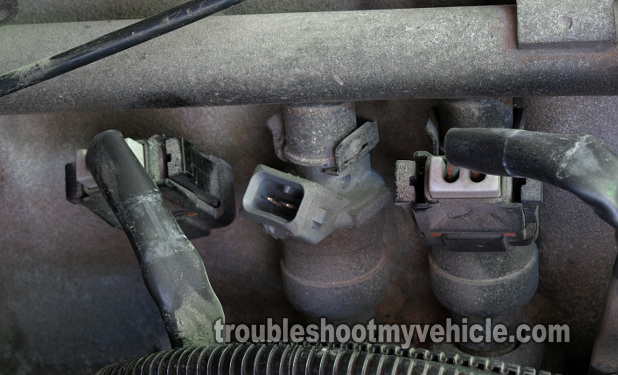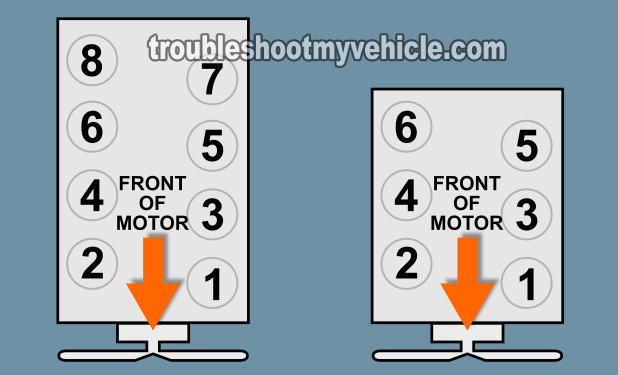
In this article, I'll show you how to test for a bad Dodge 3.9L, 5.2L, 5.9L fuel injector with a multimeter.
It's rare for fuel injectors to go bad, but that doesn't mean it doesn't happen and when it does you'll have a rough idle/misfire condition on your hands.
Contents of this tutorial:
- Symptoms Of A Bad Fuel Injector.
- What Tools Do I Need To Test The Fuel Injectors?
- Where To Buy The Fuel Injector And Save.
- TEST 1: Fuel Injector Resistance Test.
- TEST 2: Swapping Fuel Injectors.
- Which Fuel Injector Do I Test First? Or Do I Test All Of Them?
- Fuel Injector Diagnostic Strategy.
- Tech Tip: Always Replace Injector O-Rings.
- Related Test Articles.
- More Dodge 3.9L, 5.2L, 5.9L Tutorials.
ES ![]() You can find this tutorial in Spanish here: Cómo Probar Los Inyectores De Combustible (Chrysler 3.9L, 5.2L, 5.9L) (at: autotecnico-online.com).
You can find this tutorial in Spanish here: Cómo Probar Los Inyectores De Combustible (Chrysler 3.9L, 5.2L, 5.9L) (at: autotecnico-online.com).
Tools You'll Need:
- Multimeter
- Pen and Paper
Tutorial Update Information
I've written a more up-to-date fuel injector test tutorial for the 1992-2003 5.2L and 5.9L V8 Dodge Ram 1500, 2500, and 3500 pickups. You can find them both here:
- How To Test The Fuel Injectors (1992-1999 5.2L, 5.9L V8 Dodge Ram Pickup).
- How To Test The Fuel Injectors (2000-2003 5.2L, 5.9L V8 Dodge Ram Pickup).
These tutorials have access to ignition system wiring diagrams.
Symptoms Of A Bad Fuel Injector
As you might already be aware, every cylinder in your 3.9L V-6, 5.2L V-8, or 5.9L V-8 needs 3 very important things to work. These are air, fuel, and spark. If one of these is missing from the mix, you'll have a ‘dead’ cylinder on your hands!
The fuel injectors are the ones task with delivering fuel to the cylinder, and so, when one engine's cylinder's fuel injector stops injecting fuel, that specific cylinder will go ‘dead‘. When this happens, your 3.9L, 5.2L, or 5.9L pickup, van, or SUV will experience one or several of the following:
- Engine will have a rough idle.
- Engine will misfire under load, especially when you accelerate your vehicle.
- Lack of power when accelerating your pickup, van, or SUV.
- Bad gas mileage.
- Since your 3.9L, 5.2L, 5.9L vehicle is OBD II equipped, you'll usually see a misfire code (P0300, P0301, P0302, P0303, P0304, P0305, P0306, P0307, P0308) lighting up the check engine light on your instrument cluster.
So, what causes a fuel injector to go bad? It's usually just old age, although not always. Which leads up to the 3 main types fuel injector failure:
- Fuel injector doesn't spray any fuel because it has fried internally.
- Fuel injector sprays fuel, but not enough (clogged fuel injector).
- Fuel injector stuck On all of the time (as soon as the key is turned On). This is usually, but not always due to a bad fuel injection computer.
This article focuses on the most common, which is when the fuel injector doesn't spray any fuel at all due to an internal short-circuit and a clogged fuel injector.
What Tools Do I Need To Test The Fuel Injectors?
To test the fuel injectors in your Dodge 3.9L, 5.2L, or 5.9L you don't need any expensive tools.
Here's a basic list of tools you'll need to test all eight fuel injectors:
- A multimeter.
- You'll only be using the multimeter to check resistance (Ohms).
- If you need to upgrade or buy a multimeter, check out my recommendation: Buying A Digital Multimeter For Automotive Diagnostic Testing (found at: easyautodiagnostics.com).
- Scan tool.
- To actually test the fuel injectors, you don't need a scan tool (since a scan tool can't dynamically test the fuel injectors). But, having one makes the whole process easier since you're able to retrieve any diagnostic trouble codes (DTCs) stored in the PCM memory.
- Don't have one? This is the one I recommend: ZM301 OBD2 Scanner Diagnostic Tool (at: amazon.com).
- Pen and paper to write down your fuel injector resistance test results.
Where To Buy The Fuel Injector And Save
You can buy the fuel injector for your Dodge pickup (van, SUV) in just about any auto parts store but you'll spend a whole lot more because they mark it up quite a bit.
My suggestion is to buy it online or at least comparison shop to get an idea of how much it costs and how much you can save.
The following links:
Disclosure: As an Amazon Associate, I earn from qualifying purchases. If my tutorials help you, using these links is an easy way to support the site at no extra cost to you. Thank you!
Not sure if the above fuel injector fits your particular Dodge or Jeep? Don't worry, once you get to the site, they'll make sure it fits by asking you the particulars of your vehicle. If it doesn't fit, they'll find you the right one.
TEST 1: Fuel Injector Resistance Test

The engine in your Dodge pick up (van or SUV) should be warmed up. If your vehicle doesn't start, don't worry about this.
The following test steps assume that you're gonna' test all of the fuel injectors but you don't have to. If you're just wanting to test one fuel injector, my recommendation is to test at least two others for the comparison values you'll need at the end of the test.
To learn more, see this section:
V6 TIP: One last thing, the following instructions also apply to the 3.9L V6 even though the instructions refer to 8 fuel injectors.
NOTE: Don't have a multimeter or need to upgrade yours? This is the one I use and recommend: Tekpower TP8268 AC/DC Auto/Manual Range Digital Multimeter (at: amazon.com).
OK, to get started, this is what you need to do:
- 1
Disconnect the fuel injector from its electrical connector.
- 2
Set your multimeter to Ohms mode.
- 3
Measure the resistance of the fuel injector.
- 4
After verifying the resistance value, write it down on a piece of paper.
Don't forget to write down what cylinder that reading belongs to. - 5
Repeat test steps 1 through 2 on the remaining 7 fuel injectors.
Write down the resistance values and the cylinder it belongs to.
Let's interpret your test results:
CASE 1: The resistance value of all 8 fuel injectors is the same. This result indicates that the fuel injectors are not fried internally.
Although the fuel injectors don't have an internal electrical issue, there's a good chance the fuel injector may be clogged.
I recommend swapping fuel injectors with another already on the fuel rail. Go to: TEST 2: Swapping Fuel Injectors.
I also suggest the test in this section: Fuel Injector Diagnostic Strategy for more troubleshooting ideas.
CASE 2: One (or more) fuel injector value is totally different from the rest. Retest the fuel injector that was not within the stated specification. If the resistance value is still the same and drastically different from the normal resistance value (or different from the rest of the fuel injectors), that fuel injector is bad. Replace the fuel injector.



